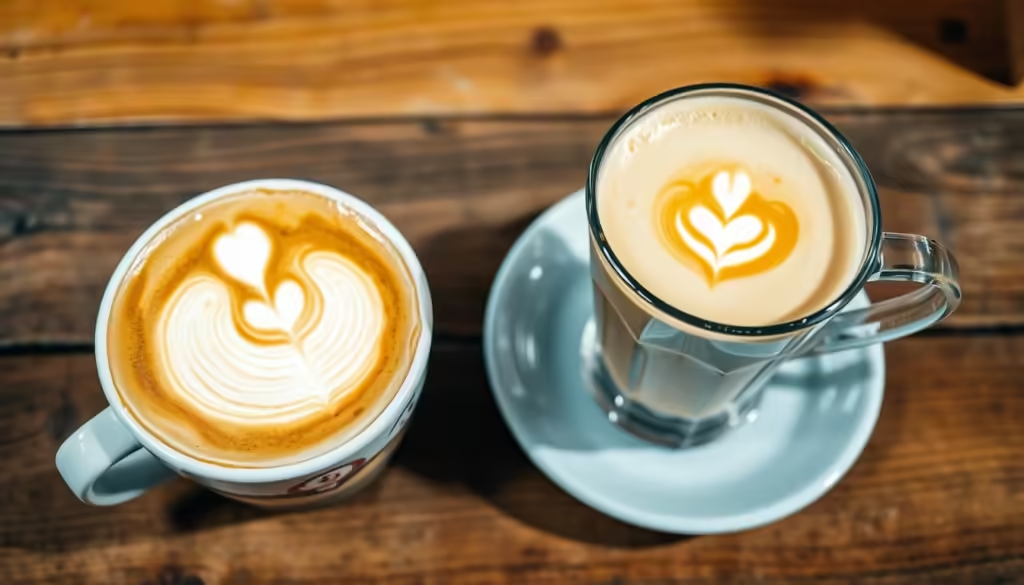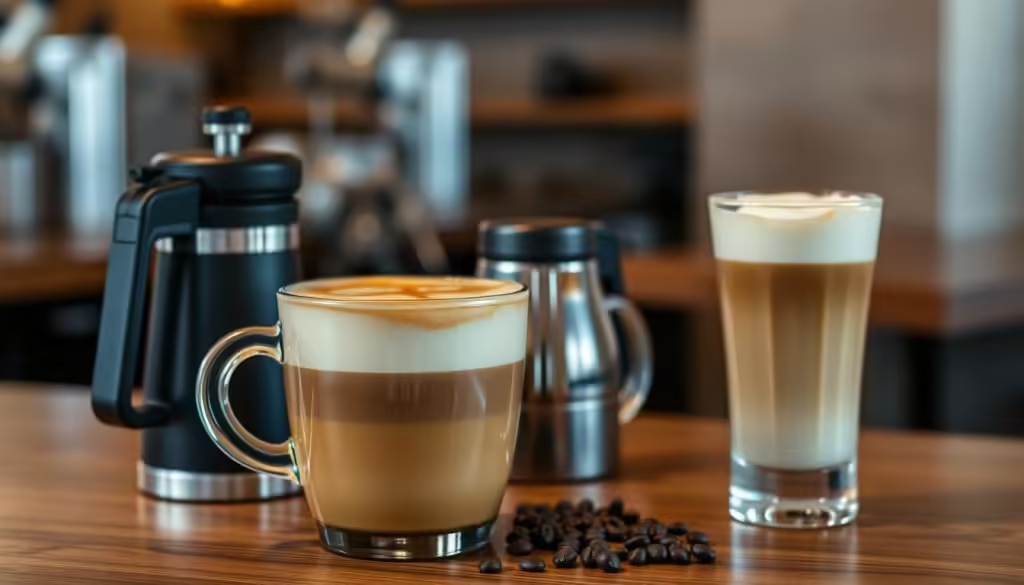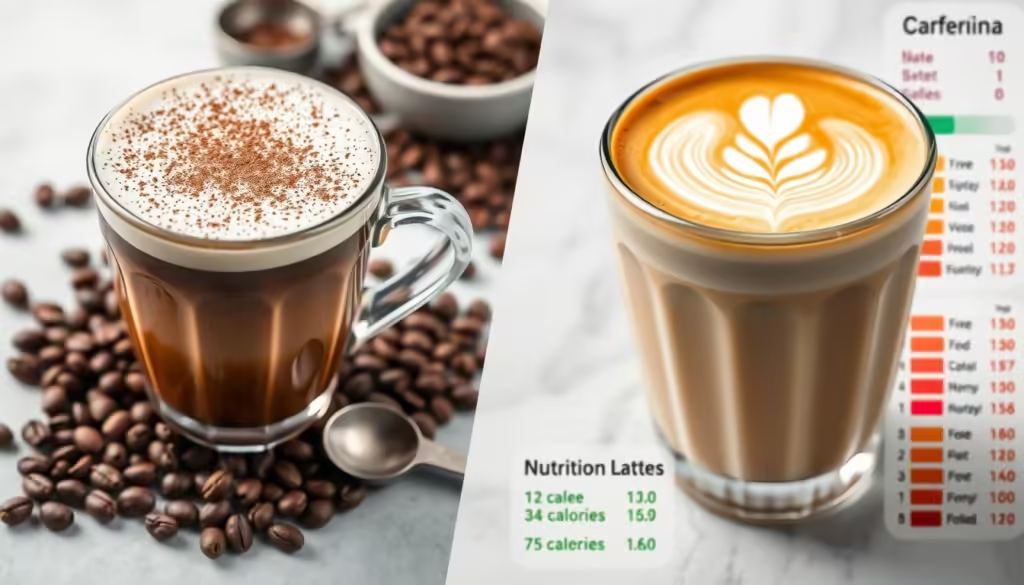
Did you know a latte has almost double the espresso of a cappuccino? This big difference in espresso to milk ratio is a key difference between these two coffee drinks. Knowing the differences can help you choose the right one and improve your coffee experience.
In this detailed guide, we’ll look at the main differences between cappuccinos and lattes. We’ll cover their ingredients, how they’re made, caffeine levels, and nutrition. Whether you love coffee or just want to learn more, this guide will give you the knowledge to enjoy specialty coffee with confidence.
Table of Contents
Understanding the Basics

Ingredients and Preparation Methods
To fully appreciate the differences between a cappuccino and a latte, it’s key to know the main ingredients and how they’re made. These details are what make these coffee drinks so beloved.
A cappuccino is made with equal parts espresso, steamed milk, and milk foam. The espresso’s rich flavor is balanced by the creamy steamed milk and the velvety foam. Cappuccinos are served in smaller cups, around 150-180 ml (5-6 fl oz), to keep the perfect mix.
A latte has a single shot of espresso mixed with three to four times steamed milk. This makes the latte smoother, milder, and creamier. Lattes are served in larger cups, 240-300 ml (8-10 fl oz), to hold more milk.
Both cappuccinos and lattes are loved for their unique tastes and textures. Cappuccinos are bold and rich, while lattes are milder and creamier.
“Cappuccinos are a staple of Italian breakfasts, while lattes have gained global popularity in the coffeehouse culture.”
Flavored syrups like vanilla, caramel, and hazelnut are popular in both cappuccinos and lattes. They let you customize your drink. Also, cafes now offer milk alternatives like almond, soy, oat, and coconut milk for different tastes and dietary needs.
Caffeine Content Comparison
Cappuccinos and lattes have similar amounts of caffeine. A 16-ounce serving of each has about 173 milligrams. This is because they both use a single shot of espresso. But, the caffeine can change based on how the coffee is made and the beans used.
Macchiatos, on the other hand, have less caffeine. A 2-ounce serving has over 85 milligrams. This is because macchiatos use less espresso than cappuccinos and lattes. So, macchiatos are a good choice if you want less caffeine.
| Beverage | Caffeine Content (per serving) |
|---|---|
| Cappuccino (16 oz) | 173 mg |
| Latte (16 oz) | 173 mg |
| Macchiato (2 oz) | 85 mg |
The amount of caffeine in coffee drinks can change. This depends on the coffee beans, brewing method, and serving size. Also, decaf drinks have very little caffeine, usually less than 2 milligrams.
Whether you like cappuccinos or lattes, remember to watch your caffeine intake. Enjoy these drinks in moderation as part of a healthy lifestyle. Knowing how much caffeine is in different coffee drinks helps you make better choices and keep your caffeine balance.
Nutritional Breakdown

Calories, Protein, and Fat
Favorite coffee drinks have different nutritional profiles. Lattes, cappuccinos, and macchiatos vary in calories, carbs, protein, and fat. This is mainly because of their milk-to-espresso ratios.
Lattes usually have the most calories and nutrients. A 16-ounce latte has about 188.5 calories and 12 grams of protein. On the other hand, a 16-ounce cappuccino has 119.7 calories and 7 grams of protein.
Macchiatos, being smaller (around 2 ounces), have fewer calories. They have just 13 calories and 0.7 grams of protein per serving.
The type of milk used affects the drink’s nutrition. Whole milk adds more fat and protein than almond or oat milk. Sweeteners also change the calorie and carb content.
If you’re counting calories, fat, and protein, choose a macchiato. But if you want more nutrients, a latte is better.
Cappuccino vs Latte: Taste and Texture
Cappuccinos and lattes have different tastes and textures. Cappuccinos have a strong espresso flavor because of their mix of espresso, steamed milk, and milk foam. Lattes are milder and creamier, with more steamed milk.
The milk foam texture sets these drinks apart. Cappuccinos have a fluffy, airy milk foam. Lattes are smoother, with less foam and more milk-based coffee drink.
| Characteristic | Cappuccino | Latte |
|---|---|---|
| Espresso Flavor Intensity | Bold and intense | Mild and creamy |
| Milk Foam Texture | Thick, frothy, and airy | Smooth and silky |
| Milk-Based Coffee Drink Mouthfeel | Lighter and more textured | Richer and creamier |
In summary, cappuccinos and lattes offer unique tastes and textures. Their coffee drink flavors, milk foam texture, and milk-based coffee drink mouthfeel make them special for coffee lovers.
Conclusion
Choosing between a cappuccino and a latte depends on your coffee taste. Cappuccinos mix espresso, steamed milk, and frothed milk for a strong coffee taste. Lattes, with more steamed milk, are creamier and sweeter.
Do you like the bold espresso of a cappuccino or the smooth latte? Knowing the differences helps you pick the right coffee. You can also add different milks or syrups to make it your own.
Cappuccinos and lattes are favorites for many coffee lovers. They offer something for everyone. By trying both, you can find the perfect coffee that suits your taste and makes your coffee time even better.
